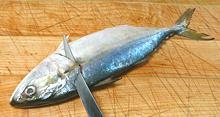
Cut behind collar
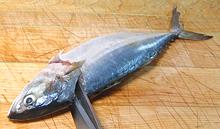
Cut the backbone
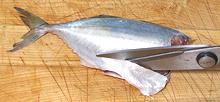
Cut off skirts
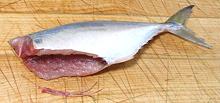
Pull all ribs
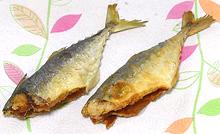
Fried crisp and draining
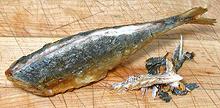
Pull the fins
Serve whole or . . .
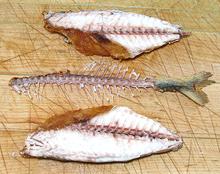
Remove fillets
This is a fairly meaty fish with fairly light flesh that is milder than most mackerel, but definitely could not be called "fish lite". There is a substantial streak of dark meat under the skin along the lateral line. The flesh stays firm for all methods of cooking but breaks up easily on the plate into large flakes. My favorite way to enjoy these is to fry them with a light powdering of rice flour and eat with a simple sauce. The flavor of the flesh works well fried.
Small bony fish like this take a little special handling to be easily edible and not take too much time to prepare. The instructions below will produce good results with minimum effort. They will also work with other small bony fish.
Buying:
This fish is particularly available from Philippine markets, both on ice and dried, and from other Asian markets serving a Southeast Asian community. From the ice, I have paid 2014 US $1.99 / pound. Frozen 4 to a bag from a large Asian market in Los Angeles (San Gabriel), I paid 2017 US $1.35 / pound.Scales:
As with most mackerels, this one has only a few scales right behind the gill covers, just enough to be kosher. They scrape off easily.Clean:
Nothing unusual here. You won't be using the heads, so no need to pull the gills.Skin:
As with other mackerels, the skin is too thin and delicate to remove. Leave it on for all methods of cooking. It's flavor is stronger than the light flesh, but milder than the dark. It has no significant shrink during cooking.Fillet:
These fish fillet quite easily. The ribs just pull right out of the flesh. There will be tiny centerline pin bones for 2/3 of the length, which are easy to find and very easy to remove with long nose pliers, several at a time. In smaller fish that are to be fried, they will probably just disappear.Yield:
A 10-1/2 inch fish weighing 8-1/4 ounces uncleaned yielded 4 ounces of skin-on fillet (48%). Smaller fish don't yield a lot less.Method:
- First scale and clean the fish the normal way. The method is on our Cleaning & Filleting Round Fish page (even though this fish is a bit flat).
- Make a cut to the backbone behind the collar on both sides.
- Use your kitchen shears to cut through the backbone.
- Use your kitchen shears to cut off the skirts diagonally (there's little meat there anyway).
- Find all the rib bones, full length or cut short with the skirts, and pull them out with your long nose pliers. You can easily find them with a finger tip, and they pull easily.
- Options: At this point you could fillet the fish if you desire, they fillet easily - or you can follow the steps here and fry as pan dressed. You could also poach, steam or bake the pan dressed fish instead of frying, but the fins are then more trouble to pull out because they fall apart. If you will use the fish in soups or stews, definitely fillet, or the fins will fall apart and be very unpleasant.
- Lightly powder with rice or wheat flour and fry (rice flour is lighter in taste and browns lightly). Deep frying is easiest but you can pan fry them in about 1/8 inch of oil. If you pan fry, you can finish brown them by stand them upright, they'll have spread out so they'll stand up. Drain on paper toweling.
- Pull the fins, full length, from both top and bottom. This removes all the most pesky tiny bones and just leaves a groove where the fins were.
- Serve whole if desired. It's easy to eat the flesh off the main bones.
- Optionally, you can remove the fillets. They'll come off intact, very easily and be entirely bone free.
- Warn your guests to watch for bones anyway, just to be safe.
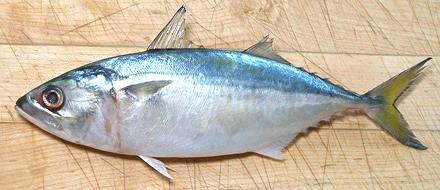 [Alumahan (Philippine); Rastrelliger kanagurta]
[Alumahan (Philippine); Rastrelliger kanagurta]